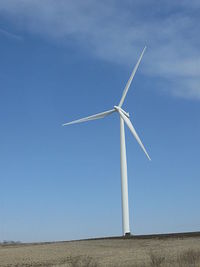Betz limit

The Betz limit is the theoretical maximum efficiency for a wind turbine, conjectured by German physicist Albert Betz in 1919.[2] Betz concluded that this value is 59.3%, meaning that at most only 59.3% of the kinetic energy from wind can be used to spin the turbine and generate electricity. In reality, turbines cannot reach the Betz limit, and common efficiencies are in the 35-45% range.[2]
Wind turbines work by slowing down passing wind in order to extract energy. If a wind turbine was 100% efficient, then all of the wind would have to stop completely upon contact with the turbine, and by looking at a wind turbine such as the one in Figure 1 it is clear that this isn't possible. In order to stop the wind completely the air wouldn't move out of the way from the back of the turbine, which would prevent further air from coming in, making the turbine stop spinning.
For a slightly technical derivation of the Betz efficiency limit, click here.
References
- ↑ Wikimedia Commons [Online], Available: http://commons.wikimedia.org/wiki/File:Wind_turbine_walnut_iowa.jpg
- ↑ 2.0 2.1 REUK, Betz Limit - Wind [Online], Available: http://www.reuk.co.uk/Betz-Limit.htm

